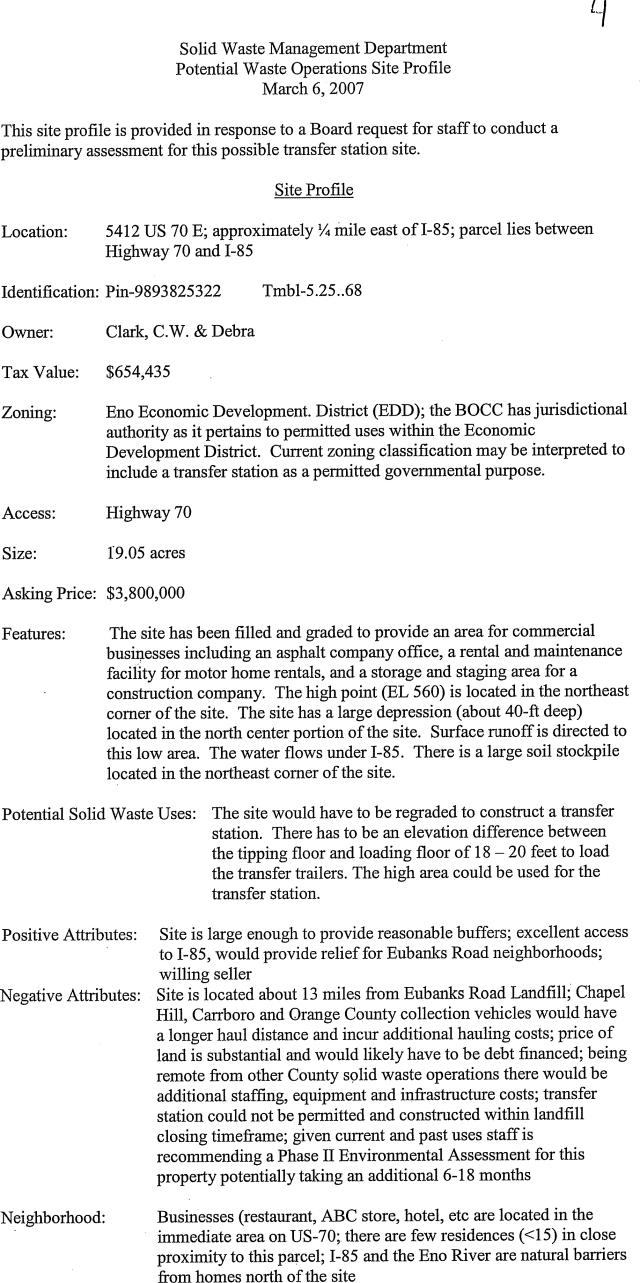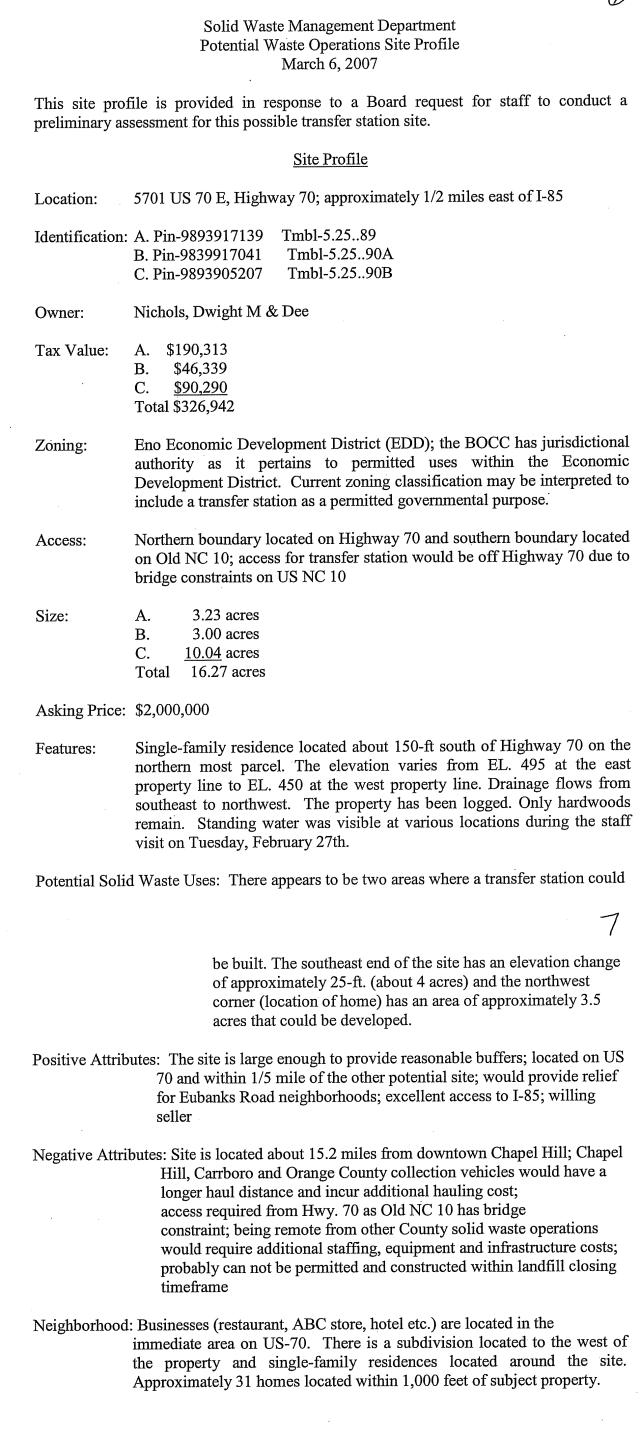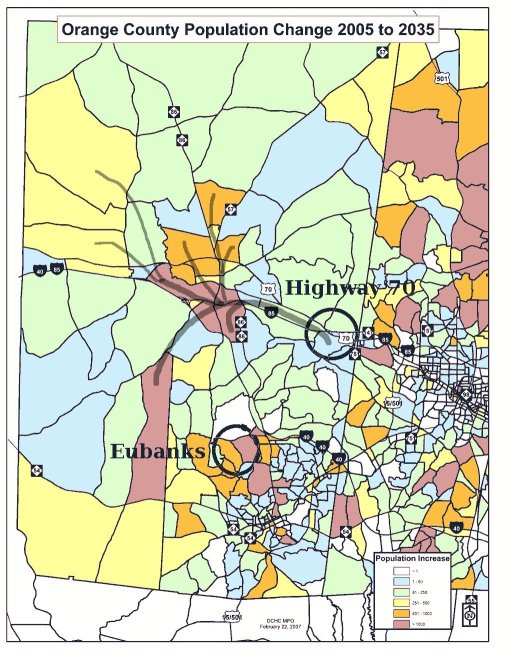A Lion used to prowl about a field in which Four Oxen used to dwell. Many a time he tried to attack them; but whenever he came near they turned their tails to one another, so that whichever way he approached them he was met by the horns of one of them. At last, however, they fell a-quarrelling among themselves, and each went off to pasture alone in a separate corner of the field. Then the Lion attacked them one by one and soon made an end of all four.
Aesop, 6th Century BC
Had an opportunity tonight to listen in on a group of concerned Hillsborough and southwest Orange County citizens discuss the potential siting of the trash transfer facility in their neighborhoods (Eno River Economic Zone – 2 sites and Hwy. 54 corridor – 3 sites).
A number of issues were raised at the meeting: apparent bias in site selection, the “surprise” announcement of the sites on Hwy. 54 and the Hillsborough zone, weighting of access to water and sewer hookups sans cost of making those connections, inadequate traffic studies, confusing or misapplied scoring of technical criteria, whether the BOCC would implement the more costly enclosed transfer site design previously proposed for Eubanks or shave some costs by going with an open pavilion, concern that Chapel Hill’s/Carrboro’s increased transportation costs were improperly used to justify removing Durham County’s transfer site from consideration, underestimation of water use (500 gals. a day!), possible “hidden” reasons for acquiring 82 acres ($7.5 million the current asking price) instead of a smaller tract, if incineration and ultimate in-county disposal got due attention and a slew of others which I’m sure the Rogers Road community are well acquainted with.
Nathan Robinson, the environmental engineer I wrote about Sept. 16th, a founding member of Orange County Community Awareness, gave the clearest deconstruction of the current solid waste transfer site selection mess that I’ve seen. Orange County’s consultant, Olver, should review his presentation to improve their own dog-n-pony show.
Nathan quickly out-lined the dimensions of the issue, discussing what a solid waste transfer site does, how it is laid out, managed and maintained before launching into an analysis, from his professional viewpoint as an environmental engineer, of the problems associated with the current siting process.
Nathan’s concerns mirror a number of mine, especially in terms of the weighting of the selection criteria, the incredibly confusing community criteria feedback procedure, biased scoring of the technical criteria, analysis of environmental consequences and the evaluation of Orange County’s waste creation “center of gravity” (my Mar. 9th, 2007 post on that issue: 2035 Orange County’s Garbage Center of Gravity? ).
As folks that have read my ‘blog know (or have heard me whinge on about local issues elsewhere), I promote reality-based decision-making using measurable criteria. Not all issues are amenable to this approach. Sometimes you have to make a subjective call – say as to the weighting of the importance of environmental justice in the current transfer site process. As I noted a couple years ago, the previous decision by Orange County’s Solid Waste Advisory Board to plop this new facility back on Eubanks sorely lacked rigor, objectivity and transparency.
I questioned SWAB’s ability to make a sound decision because they didn’t generally use objective, understandable, measurable criteria – technical or otherwise – and what criteria they did use were inequitably evaluated differently depending on context and perceived necessity.
Because of that disconnect, I lobbied the Board of Commissioners (BOCC) to create a more thoughtful process grounded by sound engineering principles, guided by community standards. I was encouraged by the process they adopted, but, just as the BOCC themselves admitted on return from their summer break, greatly concerned by Olver’s implementation.
The folks of Rogers Road shared my concerns and expressed their uneasiness at the BOCC’s Sept. 16th meeting.
Of the concerns expressed and the comments made at the meeting, two need serious highlighting.
First is the statements by Hillsborough’s elective folks – like Mayor Stevens and Commissioner Gering – to this community that “they didn’t know” about the process or potential siting of the solid waste facility near Hillsborough. I attended several Assembly of Orange County Governments meetings where these issues got a thorough airing. As a quick Google of minutes of these meetings document, Hillsborough’s reps had to know that these sites were in-play.
Second, and really the most encouraging of all the comments, was Nathan’s call to adopt a united and collaborative approach in dealing with these outstanding issues.
He said, clearly, that he has come to understand the depth of Rogers Roads concerns, their 36 year struggle to simply have promises made – promises completed. He said, clearly, that equitable environmental justice was a relevant criteria and that this was not a battle between neighbors. When a few comments from the folks assembled veered into the “us versus them” realm, Nathan and some of the other organizers rose to say that their emphasis was on the overall process – their focus to get an reliably objective analysis within the established criteria and remove the confusion around the more subjective components of Olver’s mission.
Finally, and the most heartening of all, Nathan said he was meeting with Rogers Road resident (and champion) Rev. Campbell today to see how they could work together. I well remember the landfill expansion fight – which pitted neighbor against neighbor. An attempt to avoid that rancor from the outset gives hope the community won’t fracture. Interestingly, the folks around the county starting to deal with UNC’s new airport authority, already recognize that a united approach is a better approach.
My hope? That the BOCC improves the process. That they realize that the solid waste transfer decision is a beginning. And they work knowing how these issues are resolved will set the template for the new landfill selection process.
If you’re just stumbling upon my site and want some background, here’s a few posts and links to get you up to speed:
- Orange County Community Awareness (Nathan’s group)
- Orange County Solid Waste Advisory Board
- Details from Olver, Orange County’s consultants developing the transfer site plan, on their proposal.
- Trash Talk: Time for a New Landfill
- Transfer Site: Sept. 16th Live ‘Blog
- Trash Transfer Site: And then there were seven?
- Rogers Road Community, A Unified Front
- Is the Rogers Road Community Worth $53,000?
- Trash Talk: I Like Vinegar on My BBQ
- Trash Talk: Systematic is the New Watchword
- Trash Talk: Do You Have A Minute? How About 17 Years Worth? [selected minutes over 17 years documenting the continued inability of our local governments to deal with the Rogers Road community’s issues]
- Trash Talk: March 13ths Board of Commissioners Review
- Trash Talk: Waste Not Methane, Want Not Energy – A Few Examples
- Trash Talk: Waste Not Methane, Want Not Energy – Additional SWAB Conversations
- Trash Talk: 1 Megawatt of Waste Not Methane, Want Not Energy, April’s SWAB Report Reveals Opportunity
- Trash Talk: If Not Eubanks, Where?
- Trash Talk:Media Steps Up to the Plate
- Trash Talk: SqueezeThePulp Led Online
- Trash Talk:Aarne Vesilinds History[good historical overview]
- Trash Talk: Promises Unmet
- Trash Talk: The Ticking Clock
- Trash Talk: Mayor Chilton’s Letter
- 2035: Orange County’s Garbage Center of Gravity
- Rogers Road Trashed Again? Carrboro Board of Alderman Weigh In
- Trashing the Rogers Road Community, Again!
- Rogers Road: Mapping Out the Future
- Rogers Road Small Area Plan, It’s About Time…
Additional posts on the issue are available by doing a search on “trash” from the sidebar.





